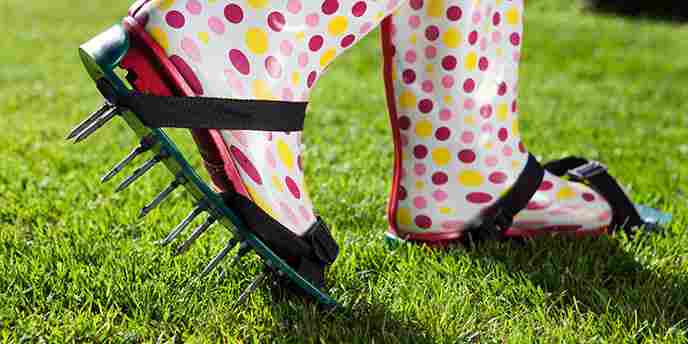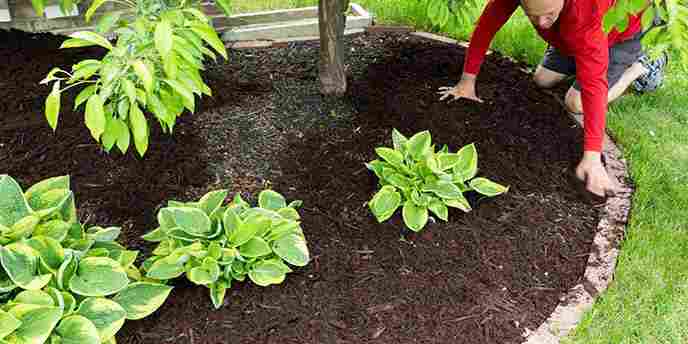June 12,2022
The Ultimate Fall Yard Cleanup & Maintenance Checklist
by Jennifer Cameron inGarden Style
As summer comes to a close, you might be thinking about hanging up the lawn care tools until spring rolls back around. But surprisingly, autumn is the ideal season to prepare your lawn for the chilly months ahead. In fact, if you put in the time to care for and clean up your yard this fall, you’ll be greeted by a lush and green lawn come springtime.
So, what sort of TLC does your yard need now to look its best next year? Follow our fall yard cleanup and maintenance checklist to learn everything you need to know.
8 Fall Yard Care Tasks to Tackle Before Winter
1. Remove Any Debris
As the trees shed their foliage, you’ll want to rake regularly to help remove dead leaves and other debris that will smother the grass and prevent growth. Organic waste like leaves and weeds can provide a haven for pests like mice and groundhogs. In addition to having little critters running in your yard, excessive yard debris can cause damage to your yard’s drainage , which can cause a problem once all the snow melts.
Here a few fall yard cleanup tips to help you keep your leaf piles under control:
Best Ways to Remove Leaves from Yard
Not sure what to do with all that natural debris? Learn how to get rid of leaves and yard waste .
2. Take Out Dead Shrubs and Trees
Now that a full season of sunshine has passed, have you noticed any shrubs in your yard that didn’t seem to grow the way you had hoped? Check for signs of life by scratching the bark at the base to see if there is any green under there. If no green appears under the bark, it might be dead.
If the tree or shrub is completely dead, it’s best to cut it down and dig it out before the ground hardens. But you don’t have to mourn for too long – fall is a great time to plant trees and shrubs for maximum growth.
Tips for Cleaning Out Dead Trees and Shrubs in the Fall
3. Don’t Stop Mowing Just Yet
Fall yard maintenance is all about helping your lawn finish strong so that it can withstand the bitter temperatures ahead. It’s important to continue watering and mowing your lawn as needed. Once the season draws to a close and the temperature begins to drop, you should set your mower’s blades to their lowest setting for the last two cuts of the season. This will allow more sunlight to reach the crown of the grass and allow the soil to dry out faster in the spring.
Pro Fall Yard Care Tip: Only cut your grass if it is still growing. Once the temperatures consistently drop below 50 degrees during the day, it’s time to put away the mower for the season.

4. Aerate the Lawn
Aerating your lawn can remove thatch, alleviate soil compaction and beautify your grass overall. Having excess thatch or heavy organic debris under the grassy surface can starve the roots from essential elements like air and water. Experts say the best time to aerate your lawn is in the fall during the growing season. Grass can heal and fill open areas more quickly once soil plugs are removed.
The easiest way to aerate your lawn is to purchase or rent a gas-powered aerator from your local hardware store. Smaller lawns can be aerated using spiked lawn aerator shoes, but for lawns bigger than three acres, you might want to hire a landscaper instead of spending an entire afternoon digging holes yourself.
Pro Fall Yard Care Tip: Aerate and seed your lawn early in the fall with cool-weather grass seed to take advantage of the warmer soil. Overseed and overwater your lawn to maximize the aeration process and give your new grass a quick kickstart.
5. Add Fertilizer
There is no better feeling than strolling around your neighborhood with a sense of pride knowing that your grass is the greenest and lushest of them all. Accomplishing this feat does not come easy and requires some additional ingredients beyond just water and sunshine. Fall’s cooler temperatures and morning dew provide the perfect setting to fertilize your lawn to regain strength from the stressful summer heat.
“Fall is the best time to fertilize as it helps your lawn develop a stronger root system over the winter months for a thicker, more vigorous lawn the following spring. Watering is optional [after fertilizing], but it will activate the fertilizer and begin the feeding process. You can simply wait until the next rainfall, unless your daytime temperatures will exceed 85 degrees. If temperatures are extremely high, we do recommend watering immediately after application.”
 “Fall is the best time to fertilize as it helps your lawn develop a stronger root system over the winter months for a thicker, more vigorous lawn the following spring. Watering is optional [after fertilizing], but it will activate the fertilizer and begin the feeding process. You can simply wait until the next rainfall, unless your daytime temperatures will exceed 85 degrees. If temperatures are extremely high, we do recommend watering immediately after application.”
“Fall is the best time to fertilize as it helps your lawn develop a stronger root system over the winter months for a thicker, more vigorous lawn the following spring. Watering is optional [after fertilizing], but it will activate the fertilizer and begin the feeding process. You can simply wait until the next rainfall, unless your daytime temperatures will exceed 85 degrees. If temperatures are extremely high, we do recommend watering immediately after application.”Jessica, Brand Ambassador | Scotts

6. Mulch Around Plants and Trees
Mulching around plants in the fall season has all kinds of benefits, from preventing soil erosion to suppressing weeds. Be sure to give perennials and cool-weather annuals a 2 to 3-inch layer of mulch to keep them healthy during the cold season. Applying mulch in the fall can also act as a weed suppressant, leaving you with no weeds to pull in the spring.
Pro Fall Yard Care Tip: Save money by using organic mulches like pine needles, straw, sawdust, fallen leaves, and grass clippings to introduce essential nutrients into the soil.
7. Rake Over Bald Spots
Is your lawn looking a little patchy? Fall is also a great time to handle any bare, bald spots on your lawn. The easiest way to handle the dead areas in your lawn is to pick up an all-in-one lawn repair mixture from your local home improvement or lawn care store. This solution usually contains a mixture of grass seed, fertilizer, and organic mulch.
8. Don’t Forget About Garden Maintenance
Caring for your garden in the fall will make all the difference when you go to plant your produce in the spring again. Before the cold temperatures harden the ground, remove all weeds and debris to eliminate enticing homes for insects and diseases in the winter. Water your garden plants diligently and they will be thanking you all winter long. You might want to consider trimming perennial vegetables and herbs back a few inches once the ground is frozen.
Finished Cleaning Up? Tackle Other Outdoor Projects While You Can
Now that your yard is ready for the cold months ahead, check out these other outdoor home improvement projects that you can tackle before the snow starts falling:
